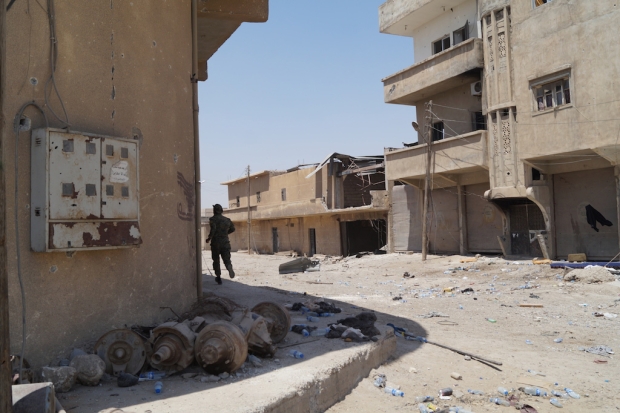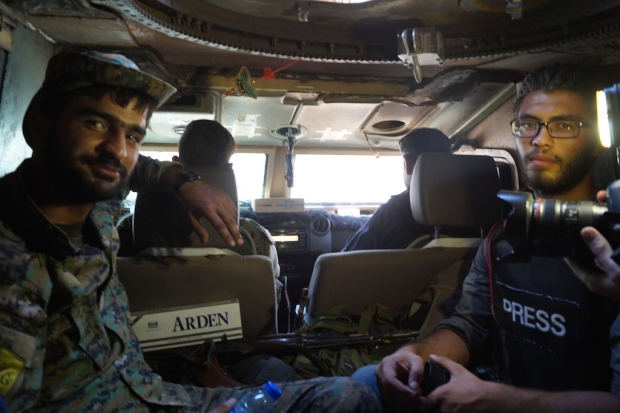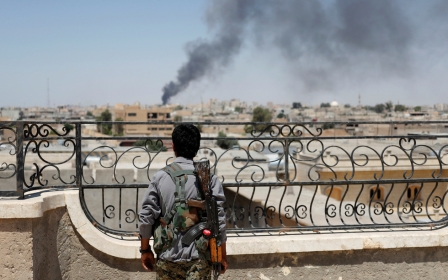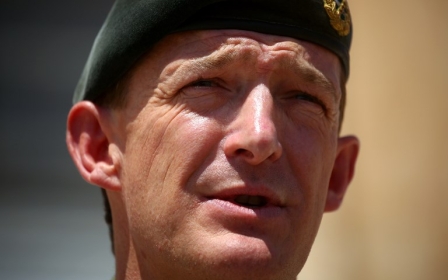Raqqa: IS sows chaos as suicide and tunnel attacks blur front lines

RAQQA, Syria – A white car sped through the narrow streets of the al-Mashlab district of Raqqa, rushing towards its target as it passed between half-demolished buildings.
Moments later, smoke rose through the rubble and debris as it detonated its explosives, wounding two journalists and two fighters in an attack that marks the constantly shifting front lines of the Syrian Democratic Forces' (SDF) battle to capture Raqqa from the Islamic State (IS) group.
Shortly after Wednesday's attack, the journalists arrived at a field hospital a few kilometres outside Raqqa. The car and equipment of Kurdistan 24 journalist Redwan Bezar and his team had been destroyed by the force of the suicide blast. Reporter Ala Saadun was also hurt.
Later that day, IS published images of the attack - in which two anti-IS fighters were also wounded - including the name and photo of the suicide bomber who was identified by the militant group as Abu Malik from Damascus.
The Mashlab district is one of several areas that have recently been liberated by the SDF, which launched the Raqqa operation accompanied by US-led air strikes on 6 June.
Battling underground?
Although it was unclear how the IS suicide car bomb ended up in the supposedly liberated neighbourhood, SDF fighters suggested the car may have come from "underground".
British SDF fighter Jac Holmes, 24, told Middle East Eye that IS was increasingly making use of tunnels to move into areas under SDF control.
"They have a lot of tunnels, they can pop up from behind us at any time," Holmes told MEE. "It is very dangerous," he added while standing in a coordination base 800m from the IS frontlines northeast of Raqqa.
According to Holmes, the base had recently been moved farther away after IS militants shot at it from about 200m.
An assessment made in early July by Reach, an NGO that works to facilitate humanitarian aid work and planning, revealed that extensive digging of tunnels and trenches by IS had destroyed sewage systems in Raqqa.
Reports of underground tunnels being used by IS to wage battles in Syria and Iraq are not new. A recently discovered large tunnel running for 2.5km under the southern outskirts of Mosul had served as an IS training camp for its most elite fighters for three years.
MEE was unable to independently confirm the size of the reported tunnel network in Raqqa.
Dangers for journalists
Wednesday's attack was not the first time that Bezar has been wounded near the front line of the conflict. When SDF forces arrived in Raqqa city in early June, Bezar and two other journalists were lightly injured when an unknown drone hovering in a neighbourhood recently liberated by the SDF in the east of Raqqa dropped explosives near them.
It was not immediately clear if IS hit the building on Wednesday with the aim of targeting journalists. The group has brutally killed journalists in their custody in the past, including in 2015 when they beheaded Japanese journalist Kenji Goto. A year earlier they killed American journalist James Foley and American-Israeli journalist Steven Sotloff.
Despite the relative safety of journalists with SDF troops in Raqqa, compared with earlier battles in Mosul, the SDF does not always allow journalists on the front, fearing for their safety.
"They [journalists] wanted to go nearer the front lines, but they were not allowed [by the SDF]," Holmes told MEE.
"You cannot walk around there during the day, because you would get shot by snipers," Holmes said.
At least 109 journalists have been killed in Syria since the start of the conflict in 2011, according to research by the Committee to Protect Journalists.
Ongoing battle
The US-backed SDF battle to root out IS from Raqqa began quickly. But according to SDF and US officials, things have slowed down and it is becoming more difficult to put a timeline on the operation.
"In less than two months from when they started, they [SDF] had seized at least 45 percent of the city," a US official, who did not wish to be identified, told MEE. "But just like Mosul, it'll probably get tougher as they get nearer the centre."
"They've [the SDF] got a long way to go in Raqqa," the official added.
Foreign volunteers serving with the SDF agreed.
"The fight will continue for a long time… it may last for days or weeks," Holmes told MEE. "But if things keep moving as they are, the battle may finish in a couple of months," he added.
Despite the drawn-out nature of the battle for the city, an SDF fighter says IS remains a powerful force and have had more than three years to prepare for the fight.
"IS are still very strong," said Heval Arges, a 44-year-old Spanish fighter. "They have a lot of ammunition and weapons.
"I am surprised that they've managed to keep all this stuff after all of the [coalition] bombardments."
"We have planes on our side, so they are using everything they've got," added fellow fighter Holmes. "Mines... heavy weapons... hiding in buildings and moving through holes in the walls," he said.
Nevertheless, the SDF has relentlessly advanced towards Raqqa's city centre since it launched the operation, according the US-led coalition.
IS tactics
Still, Holmes said, IS has resisted fiercely since the SDF penetrated near the city centre.
"When we reached the inside of the ancient walls, they put up quite a resistance," said Holmes. "They are [continuing to] fight, but they are hiding at the same time… [away from the] planes… trying to bomb them," he added.
In addition to fighting from inside buildings to avoid being attacked by US air strikes, IS has also been hiding its weaponry to avoid being spotted and destroyed by US drones, said Arges.
"They have been hiding heavy weapons inside buildings, so it's difficult to see them," he told MEE. "Most of the time they hide in a building and shoot at us, but nobody can see from where."
Despite the difficulties faced by SDF fighters in the operation, the relatively small number of civilians remaining in the city has made the fight easier than it was for US-backed Iraqi forces as they took West Mosul with 100,000 civilians trapped in the city last month.
According to a recent assessment by the NGO Reach, the number of civilians trapped in Raqqa is between 10,000 and 25,000. Moreover, according to the report, 14 of Raqqa's 24 neighbourhoods were abandoned by residents while almost all Mosul's neighbourhoods were populated when the Iraqi forces moved in.
"I have been on the front for three weeks now and I haven't seen any civilians," Holmes said. "I know there are thousands in Raqqa [and] most of them want to leave and come to our side where they will be safe, but IS is keeping them as human shields," he said.
New MEE newsletter: Jerusalem Dispatch
Sign up to get the latest insights and analysis on Israel-Palestine, alongside Turkey Unpacked and other MEE newsletters
Middle East Eye delivers independent and unrivalled coverage and analysis of the Middle East, North Africa and beyond. To learn more about republishing this content and the associated fees, please fill out this form. More about MEE can be found here.






